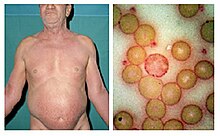Sézary syndrome
| Classification according to ICD-10 | |
|---|---|
| C84.1 | Sézary syndrome ICD-O M9701 / 3 |
| ICD-10 online (WHO version 2019) | |
Sézary syndrome , named after the French dermatologist Albert Sézary (1880–1956), is a cutaneous T-cell lymphoma with the symptoms : extensive reddening of the skin ( erythroderma ), severe itching ( pruritus ), enlarged lymph nodes , often hair loss ( alopecia ) of the entire body hair, excessive cornification ( hyperkeratosis ) and nail malformations (onychodystrophy).

Sézary's syndrome is characterized by atypical (degenerate) T lymphocytes ( Lutzner cells ) that are circulating in the blood and found in the skin biopsy .
The most important differential diagnosis of Sézary syndrome is mycosis fungoides , the most common subtype of cutaneous T-cell lymphomas. Both diseases are treated with PUVA , sometimes in combination with retinoids , whereby Sézary's syndrome has a worse prognosis than mycosis fungoides with a cure rate of about 50%. Extracorporeal photopheresis is also effective in Sézary syndrome . In advanced stages, attempts at therapy with interferons or chemotherapeutic agents can be undertaken. In addition, the monoclonal antibody mogamulizumab has been approved for the treatment of Sézary's syndrome in the EU since 2018.
Further differential diagnoses include the atopic skin diseases neurodermatitis and psoriasis .
literature
- Pschyrembel Clinical Dictionary . 257th edition. Verlag Walter de Gruyter, 1993, ISBN 3-933203-04-X , p. 1016
- Harrison's internal medicine . 15th edition (German edition). Vol. 1, McGraw-Hill / ABW-Wissenschaftsverlag, 2003, ISBN 3-936072-10-8 , pp. 357f.
Web links
- Entry on DermIS (portal of the University of Erlangen-Nuremberg and the University of Heidelberg) on Sézary syndrome with images
- Entry on Sézary syndrome in Altmeyer's encyclopedia (online), Springer 2017
Individual evidence
- ↑ Anonymous: Poteligeo. September 24, 2018, accessed June 8, 2019 .
